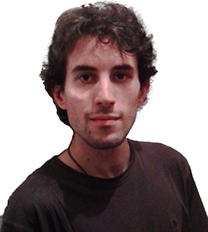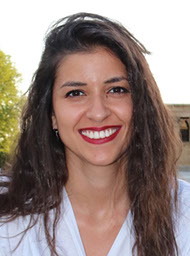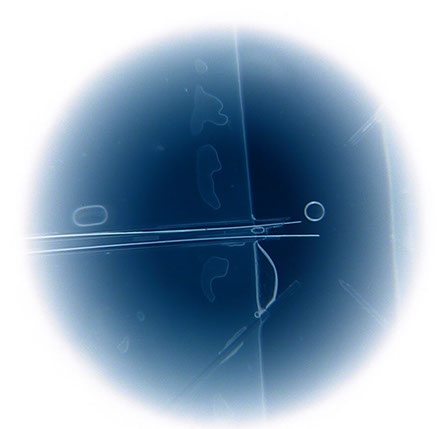Héctor Rodríguez
He obtained the Degree in Physics by the University of La Laguna (Spain), where he has collaborated with the Laser Spectroscopy and High Pressure Group about the optical trapping and binding of microspheres and the study of luminescent ions.
He completed his training with the Advanced Materials Master Degree in the Autónoma de Madrid University. He has investigated optical trapping of luminescent nanoparticles in the Fluorescence Imaging Group in this university. He has studied this topic deeply by means of stays in the Heriot-Watt University of Edinburgh and the University of Verona.
At present he is a PhD student in the Optical Nanomanipulation Laboratory of IMDEA Nanoscience Institute, co-directed by Beatriz Hernández-Juárez. His interest is centered on electromagnetism, especially in the physic fundament behind optical trapping and the matter-radiation interaction.

J. Ricardo Arias-Gonzalez
He received both his master degree in theoretical physics in 1997 and his Ph.D. in 2002 from Complutense University in Madrid (Spain). During his Ph.D. research in the Materials Science Institute of Madrid (CSIC, Spain) under the supervision of Prof. M. Nieto-Vesperinas, and short stays in NIST (National Institute of Standards and Technology, Washington, D.C., USA), École Centrale Paris (France), and EMBL-Heidelberg (Germany), he developed theory and simulations to understand the electromagnetic field in nanoparticles. Specifically, he studied the resonant behavior of both the near field and the optical forces in nanoparticles, as well as the far field scattered from nanoparticles hidden beneath random rough surfaces.
He became interested in biophysics by the end of his doctoral thesis, after studying the interactions between fluorescent molecules and nanoparticles, and after learning on the applications of optical techniques to unveil biological processes and biomolecular structures. Then, he decided to complement his physics background with that of molecular biophysics.
To that end, in 2003 he moved to U.C. Berkeley (USA) for his postdoctoral training under the supervision of Prof. C. Bustamante, where he studied DNA with single-molecule techniques. In 2006, he joined the National Center of Biotechnology in Madrid (CSIC, Spain) to continue his biology formation with Profs. J.L. Carrascosa and J.M. Valpuesta, who do research in the field of structural biology. While he started his independent career, he developed an experimental environment for single-molecule manipulation which includes a state-of-the-art Optical Tweezers, the Optical Nanomanipulation Lab.
He used that approach to understand the physical basis of the conformational states of double-stranded nucleic acids, DNA replication and to study structrural changes of organelles subjected to physical and chemical stimuli. Since 2008, he has been working in IMDEA Nanoscience. He is interested in understanding molecular processes which make cellular machinery function. He uses both theory and experiments whose scientific basis relies as close as possible to first physics principles. As part of a collaborative effort within IMDEA Nanociencia, he has also developed a parallel research line on nanoparticles.

Vanesa Manzaneda
She graduated in Chemistry at the University Complutense de Madrid in 2017. She performed her graduation research at the Nano & Supra-molecular laboratory, belonging to the same university, in the reconstitution of membrane proteins in gold nanoparticles coated with a lipid bilayer. She received her Master degree in Chemical Science and Technology working on the synthesis and functionalization of gold nanoparticles for cell endosomal escape studies (2018). As a fruit of a collaborative effort, she joined the Optical Nanomanipulation Laboratory as a PhD student. Her research interests are focused on the physical-chemical study of nanoparticles confining heat or light and on the biophysical study of the action mechanisms of nanoparticles in cells and DNA/RNA binding drugs in key sequences associated to tumour propagation.


Sara de Lorenzo
Sara de Lorenzo graduated in physics by the University Autónoma of Madrid. In 2005 she joined Dr. Felix Ritort Lab at University of Barcelona where she worked as a laboratory technician while completing her Master Degree. In collaboration with the MiniTweezers inventor, Dr. Steven B. Smith, she developed a new optical tweezers instrument with an advanced temperature control system.
In November of 2013 Sara joined IMDEA Nanoscience as a lab manager for Dr. J. R. Arias-González and Dr. Borja Ibarra.
Irene Gutiérrez
She graduated in Chemical Engineer at the Polytechnique University of Madrid (2012).
She received her Master degree at the Universidad Autónoma de Madrid working at the Optical Nanomanipulation Lab (2012-2013). During that time, she focused on analyzing the sequence-dependent elastic response of dsDNA and dsRNA.
Then she continued her PhD in our laboratory studying the mechanical unfolding of RNA G-quadruplexes by both optical tweezers and AFM.
In 2015, she was awarded the best oral presentation in poster format at the XV International Conference of the Spanish Bio-physical Society (SBE). In 2017, Institute of Molecular Pathology, Vienna (Austria), for her postdoct.
Thesis: The folding complexity of TERRA G-quadruplex unveiled at the single-molecule level [pdf] Universidad Autónoma de Madrid, Spain (September, 2017).
Silvia Hormeño
Dr. Hormeño joined the Optical Nanomanipulation Lab in 2004 for her PhD thesis. She performed single-molecule stretching experiments to understand the mechanical basis of A and B forms and developed the optical trapping of individual centrosomes to study their electrophysiological behavior. From 2010 to 2011 she continued her research in our lab manipulating biofunctional nanoparticles in collaboration with Dr. B. H. Juárez, at IMDEA Nanoscience. In 2012, she moved to the IMM-CSIC for her second postdoc.
Thesis: Biophysics of centrosomes and DNA studied by optical manipulation [pdf] Universidad Autónoma de Madrid, Spain (May, 2010)
Awarded the best Ph.D thesis in the area of Life Sciences by the Spanish Society of Microscopy, SME (September, 2011).
Elías Herrero-Galán
Dr. Herrero-Galán joined the Optical Nanomanipulation lab for his postdoctoral resesearch in 2009. He investigated the mechanical properties of double stranded RNA. To that end, he prepared DNA and RNA molecules of identical sequence and stretched them by optical tweezers. His studies, which combined calorimetric analysis, AFM and magnetic tweezers, lead to a general understanding of the structural basis of the different DNA and RNA mechanical properties. He completed his research in our lab collaborating in the study of the mechanical unfolding of RNA G-quadruplexes. In 2011 he continued his research at the Centro Nacional de Biotecnología-CSIC and in 2014 he moved to the CNIC in Madrid.



Collaborations in the last years
Centro Nacional de Biotecnología, CSIC Madrid, Spain
IMDEA Nanociencia Madrid, Spain
Max-Planck Institute for Molecular Genetics Berlin, Germany
Institute of Physical Chemistry and Center for Applied Nanotechnology Hamburg, Germany
School of Mathematical Sciences, Queen Mary University of London London, UK
Steven B. Smith Engineering New Mexico, USA
Universitat de Barcelona Barcelona, Spain
Universidad de Zaragoza Zaragoza, Spain
Universidad de Zaragoza Zaragoza, Spain
Alfredo Villasante
Centro de Biología Molecular Severo Ochoa, CSIC-UAM Madrid, Spain
Instituto de Química-Física Rocasolano (CSIC) Madrid, Spain
CIC-biomaGUNE San Sebastián, Spain
IMDEA Nanociencia Madrid, Spain
IMDEA Nanociencia Madrid, Spain
Belén Ortiz
She graduated in Biology in 2016 at the University of Alcalá, Spain (extraordinary graduate award). She completed her research training with a Master degree in “Therapeutic Targets in Cell Signaling: research and development”. Since 2015 she has collaborated in several research projects related to prostate and thyroid cancer in the departments of Biomedicine, Molecular Biology and Biochemistry at the same university. Her last collaboration was carried out at the Biomedical Research Institute “Alberto Sols” (Madrid), where she worked on the development of neuroprotective peptides against brain ischemia. She joined the Optical Nanomanipulation Laboratory in 2018, where she develops her PhD co-directed by Beatriz Hernández-Juárez. She is interested in the use of luminescent nanocrystals in the cell interior and other biological applications of nanoparticles.

Héctor Rodríguez
PhD Student
J. Ricardo Arias-Gonzalez
Principal Investigator
Vanesa Manzaneda
PhD Student
Sara de Lorenzo
Lab Manager
Former Lab Members
Collaborations
Belén Ortiz
PhD Student
Español
Universitat Politècnica de València Camino de Vera, s/n 46022 Valencia Dr. J. Ricardo Arias-Gonzalez



